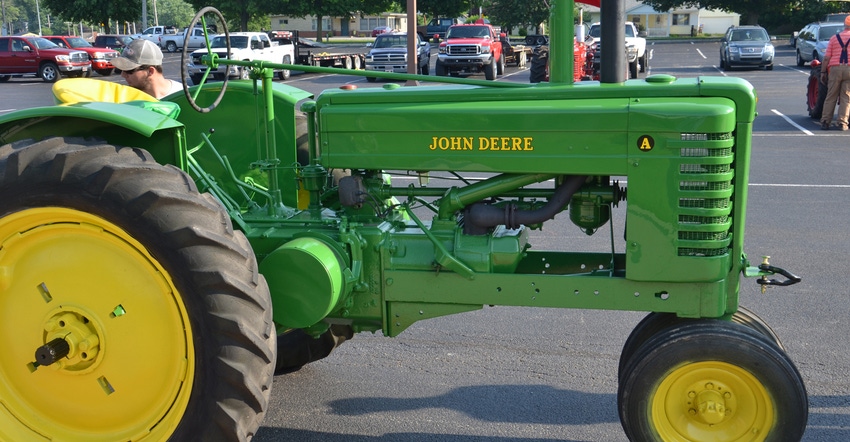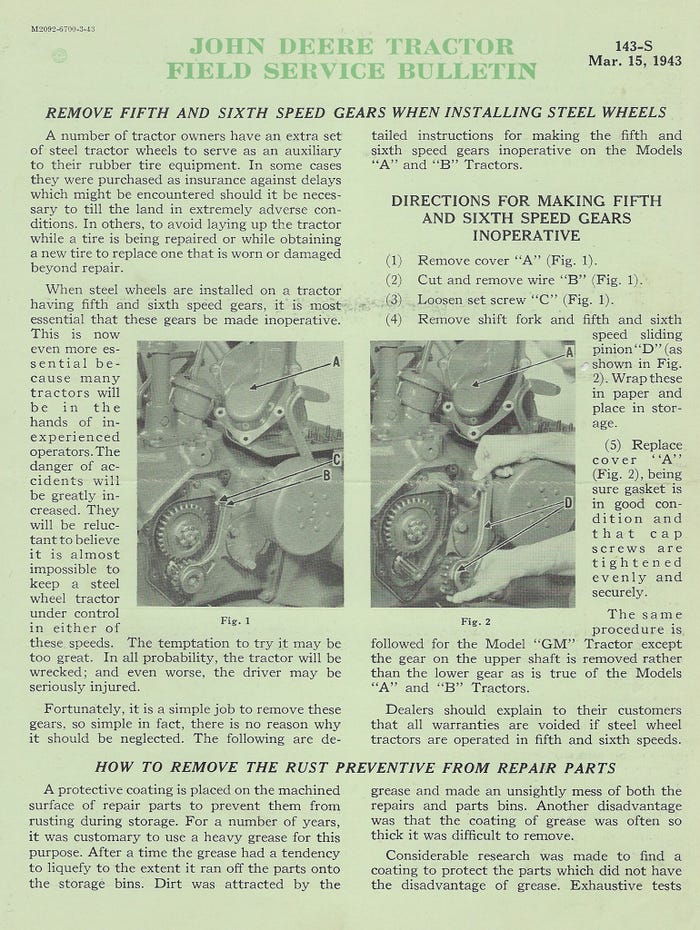August 9, 2018

Bill Walker, Clinton County, Ind., enjoys restoring and driving older tractors. He recently drove a John Deere A in the Delphi FFA Tractor Drive.
“What year is the old A?” someone asked.
Walker smiled. “Well, there is a story behind that,” he said. “I thought it was a 1939 model.”
“So it’s not a 1939?” the person asked.
“Someone who knows a lot more than me about old John Deere tractors looked at it,” Walker said. “It didn’t take him long to tell me that I had a 1940 model.”
“How did he know?” the person asked.
“Look at the oil bath cleaner,” Walker said. “The bottom canister is held on with a hook-and-bail arrangement. This person says Deere didn’t start using that system until 1940. The 1939 models had a different setup.
“I still like to drive the tractor and it restored well. I just have to say it’s a 1940 instead of a 1939 model.”
 TELLTALE FEATURE: This bail system to hold the bottom of the oil bath canister didn’t appear until 1940.
TELLTALE FEATURE: This bail system to hold the bottom of the oil bath canister didn’t appear until 1940.

According to tractordata.com, John Deere built the Model A from 1934 to 1952. It was an 18-hp tractor at the drawbar, rated as a two-plow tractor. It rated at more than 23 hp on the PTO.
Even tractordata.com doesn’t go into such details as John Deere changing the holder for the oil bath cleaner. Those types of changes — and there were many as Deere engineers tweaked models — came out regularly in John Deere Tractor Field Service Bulletins in the 1940s.
While we don’t have a copy of one noting this change, here are a couple of other examples:
• Feb. 15, 1943 — Shortcut for removal of fuel tanks from general purpose tractors. The bulletin says it was seldom necessary to remove a fuel tank on an A, B, G or H tractor. So few people had done it, and most did it the hard way — taking off the hood and removing the tank. The bulletin explains a shortcut that would allow a serviceman to change a tank without taking the hood apart. Until the bulletin came out, many repairmen did it the hard way.
 GAS TANK SHORTCUT: People didn’t communicate by text or Snapchat in 1943. Servicemen depended on information in bulletin updates from the company.
GAS TANK SHORTCUT: People didn’t communicate by text or Snapchat in 1943. Servicemen depended on information in bulletin updates from the company.

• Mar. 15, 1943 — Instructions to disable gears before switching to steel wheels. You may find this one hard to believe, but remember, World War II raged. This bulletin instructs servicemen how to disable the fifth and sixth gears on John Deere tractors if the operator wanted to switch back to steel wheels.
The bulletin says some people were doing this when plowing in adverse conditions, or to avoid laying the tractor up while a rubber tire was repaired or a new tire was obtained. Rubber tires weren’t always that easy to find during wartime.
The bulletin says: “When steel wheels are installed on a tractor having fifth and sixth speed gears, it is most essential that these gears be made inoperable.” The bulletin explains that because of the war, many operators running tractors were inexperienced. “They will be reluctant to believe it is almost impossible to keep a steel wheel tractor under control in either of these speeds.”
 SLOW DOWN, BOYS! This bulletin explains how to disable the faster gears so tractors on steel wheels couldn’t run as fast.
SLOW DOWN, BOYS! This bulletin explains how to disable the faster gears so tractors on steel wheels couldn’t run as fast.

You May Also Like




